Here's your weekly roundup of climate change news for the week of Jan. 30 to Feb 5, 2023.
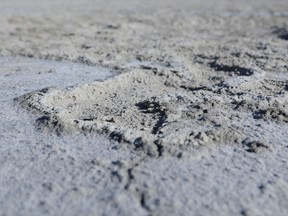
From new policies to lawsuits, there is work being done to address the inextricably linked climate and ecological crises. But is it enough and how quickly does a transition to clean energy need to happen? Here is your weekly roundup of all the latest news concerning climate change, biodiversity loss, and the steps leaders are taking to address these issues.
In climate news this week:
Start your day with a roundup of B.C.-focused news and opinion delivered straight to your inbox at 7 a.m., Monday to Friday.
Thanks for signing up!
A welcome email is on its way. If you don't see it, please check your junk folder.
The next issue of Sunrise presented by Vancouver Sun will soon be in your inbox.
• Columbia River Treaty renewal won’t just go with the flow
• B.C. road repair costs rise to almost half a billion dollars due to landslides and washouts
• Global ocean conservation conference in B.C. hopes to build on Montreal agreements
The UN’s Intergovernmental Panel on Climate Change has warned for a decade that wildfires, drought, severe weather, such as B.C.’s deadly heat dome and catastrophic flooding in 2021, would become more frequent and more intense because of the climate crisis.
The panel has issued a “code red” for humanity and last year it said the window to stop global warming from exceeding 1.5 C was closing. In April 2022, it released a report with solutions for how to drive down greenhouse gas emissions, mainly by transitioning away from fossil fuels.
There is a scientific consensus on climate change (NASA reports that 97 per cent of climate scientists agree that the climate is warming and that human activity is the cause.) Multiple studies published in peer-reviewed scientific journals show that greenhouse gas emissions are the primary cause of global warming.
Check back here every Saturday for a roundup of the latest climate and environmental stories. You can also get up to date B.C.-focussed news delivered to your inbox by 7 a.m. by subscribing to our newsletter here.
Climate change quick facts:
(Source: United Nations IPCC, World Meteorological Organization, UNEP, Nasa, climatedata.ca)
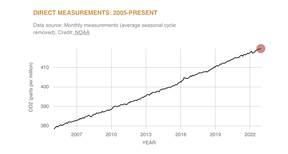
LATEST CLIMATE NEWS
The cost to repair roads damaged by landslides and washouts across B.C. could reach almost $500 million this year, almost four times the amount spent five years ago, according to Ministry of Transportation data that shows expenditures rising year over year.
Repairs due to “emergency events” in the 2022/23 fiscal year are expected to top $470 million, four times the $101 million spent in 2018/19 and more than double the $191 million spent last year, with funding coming from both the provincial and federal governments.
While much of the repairs continue to be a result of the devastating storms in November 2021, the data shows the costs associated with landslides and washouts steadily rising over the last five years.
“Even if we recognize that the events of the last year have been extreme, there’s an expectation we’ll see more of that,” said University of B.C. geology professor Brett Gilley. “It’s a complicated mess.”
Gilley said the problem is driven in part by climate change, which can bring more destabilizing events such as wildfires and rainstorms, as well as aging infrastructure.
Read the full story here.
—Glenda Luymes
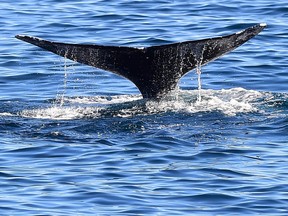
Federal politicians are expected to make a significant announcement on ocean protection during an international conference in Vancouver on how to take action on promises to protect the marine world made at recent global environment meetings.
Fisheries and Oceans Minister Joyce Murray and Environment Minister Steven Guilbeault are both to attend the IMPAC5 conference, joining thousands of delegates from 123 countries. Conference sessions begin Saturday and will last through the week.
“It is the first major international congress following COP15 in Montreal, where we will plot a course to protecting 30 per cent of the ocean by 2030,” said Ben Stanford, spokesman for the conference organizers.
In December, delegates from around the world met in Montreal to hammer out an agreement to protect global biodiversity. Included in that deal was a pledge to put 30 per cent of the world under some form of environmental protection by 2030, including the oceans.
Read the full story here.
—The Canadian Press
The B.C. government is setting aside $23.4 million in funding for 49 communities to adapt and prepare for climate-related disasters.
Bowinn Ma, minister of emergency management and climate readiness, and Kelli Paddon, MLA for Chilliwack-Kent, made the announcement at a news conference in Chilliwack Friday.
The money will go to 49 First Nations and local governments in B.C. to help them respond to climate-related emergencies, such as floods and extreme temperatures.
Some of the funding will go towards designing upgrades to the Chilliwack Creek drainage pump station, a climate and disaster risk assessment for the T’lat’lasik’wala First Nation, dike breach modelling in Squamish, and misting stations in Victoria that will keep people cool during extreme heat waves.
—Tiffany Crawford
Flood control measures are set to expire next year in the Columbia River Treaty, an international agreement that governs the flow of water between B.C. and half a dozen U.S. states.
Beginning in earnest in 2018, Canada started work to hammer out a new treaty with the U.S. that would go beyond flood management and hydro-power sharing covered by the existing deal to include the environment, First Nations interests and salmon.
The U.S. has new demands as well, including potentially more water releases to protect the environment and a reduction in hydro-power payments, $140 million a year on average in the past decade, that flows to British Columbia.
The payments come from a share of additional power generated in the U.S., most of which B.C. sells back to the U.S.
Add in climate change and the two sides are addressing much more complex issues than in the first agreement created nearly six decades ago that covers a drainage area the size of France.
Read the full story here.
—Gord Hoekstra
A California startup using rocks to soak up carbon dioxide from the air has teamed up with a Canadian company to mineralize the gas in concrete, a technological tie-up that is a first and they say could provide a model for fighting climate change globally.
U.N. scientists concluded that removing billions of tons of carbon dioxide already in the atmosphere, in addition to cutting current emissions, will be necessary to limit climate change. To do that, two things are needed: first, capturing carbon dioxide with nature or technology, and second, locking it up for centuries.
Companies are springing up to do both.
Heirloom Carbon Technologies delivered about 30 kg (66 lb) of CO2 collected from the air around its San Francisco Bay Area headquarters to neighboring Central Concrete, a Vulcan Materials’ subsidiary that on Wednesday incorporated the gas into new concrete. That’s equivalent to tailpipe emissions of driving about 75 miles (120 km) in a car.
The joint effort was the first time that carbon dioxide absorbed from the atmosphere using such Direct Air Capture (DAC) technology had been secured in concrete, where the CO2 will stay put for centuries, several scientists said.
Read the full story here.
—Reuters
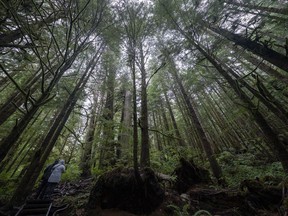
The federal Competition Bureau has opened an inquiry to see if forestry industry claims of sustainable management on vast stretches of Canadian woodlands are false advertising.
The inquiry comes after complaint was filed by the environmental law firm Ecojustice on behalf of eight environmental groups. It alleged that forest industry advertising that claims the Sustainable Forestry Initiative sets rigorous harvesting standards are dishonest and misleading.
“The (standard) does not prescribe, require, assure, command, mandate, or in any form certify sustainable forest management,” says the complaint filed to the bureau. “It allows aspirations, stated intentions, and programs to be conflated with actual outcomes.”
Jason Metnick, a spokesman for the forestry initiative, denied those allegations Wednesday. He said the program has a forest management standard based on objective performance measures and indicators.
At stake is Canada’s most commonly used method of assuring consumers that the wood and paper products they buy are harvested in accordance with modern ecological principles. It is promoted by the Forest Products Association of Canada and purports to certify sustainable forestry on more than 1200,000 square kilometres.
Read the full story here.
—The Canadian Press
South African miner Seriti Resources, a top thermal coal supplier to struggling state power utility Eskom, is investing in wind power in the latest move by industry to wean itself off a national grid plagued by power cuts.
Seriti on Thursday said it would build a 155 megawatt (MW) wind farm over the next two years that will be able to supply 75% of the power required by its coal mines in Mpumalanga, South Africa’s coal heartland.
It raises the prospect that mines powered mostly by wind would produce coal for Eskom’s power plants to burn to produce electricity.
The move by Seriti is a stark illustration of the switch to renewables being hastened by Eskom’s inability to meet demand and implementation of “loadshedding,” or scheduled power cuts, which have reached record levels.
“There are short-term solutions to alleviate some stages of loadshedding, but the only long-term solution is new generation,” said Peter Venn, chief executive officer of Seriti’s renewable energy subsidiary Seriti Green.
Read the full story here.
—The Associated Press
Early one Sunday morning in December, in a town in southwestern Mexico, dozens of people equipped with machetes hopped onto open trucks and bundled into cars and headed into the nearby forest.
A few kilometres south of Capulalpam de Mendez in Oaxaca state – on a plot of land owned by the indigenous Zapotec people – the group disembarked and started clearing unwanted vegetation threatening to hinder the growth of recently-planted pine trees.
The community’s reforestry work, however, faces new dangers as well: worsening droughts, bark beetle infestations and other problems linked to climate change.
“In this parcel, we have already planted pine trees four times, since the first three times many trees died. It is due to the late arrival of rainfalls and long droughts,” said Miguel Cosmes Martinez, who is in charge of the surveillance unit that monitors activity in the forest.
Martinez was elected by his community, with his role one of several filled by local people in the absence of state-provided services in some indigenous areas, which are self-governed.
Today, almost 80% of all land in Oaxaca is communal and governed by its indigenous population – the highest proportion among Mexico’s 32 states – according to government statistics.
Read the full story here.
—Reuters
Local climate activists in Congo are hoping Pope Francis’ visit will help spur action to protect the country’s rainforest from oil and gas interests.
The Pope’s call to protect Congo’s “great green lungs of the world” on Tuesday was welcomed by campaigners who see the papal visit as a fresh opportunity to highlight threats to the country’s biodiversity and global climate goals.
Parts of Congo’s rainforest are up for oil and gas auction and several climate activist groups are petitioning the Pope to support their stance opposing fossil fuels investments.
The activists plan to present a petition calling for the cancellation of the oil blocks leases to the Pope, who is in Congo until Friday.
“We appeal to Pope Francis to engage our government on this very crucial matter to call for the stop to these fossil fuel projects and the prioritization of renewable energy,” said Congolese climate activist Bonaventure Bondo.
Read the full story here.
—The Associated Press
Climate change. population growth could dry up the Great Salt Lake in five years: media report
The Great Salt Lake, the largest remaining saltwater lake located in Utah, could be dried up in five years, according to a report by NPR.
The report notes that scientists blame climate change and rapid population growth.
A recent scientific report from Brigham Young University warned that if no action is taken, the Great Salt Lake could go completely dry in five years, NPR reports.
The region has endured drought conditions for two decades and water diversions from rivers that feed the lake have increased to support farms and cities, according to the report.
NPR reports that a drying lake could lead to an environmental and economic collapse.
RELATED SOCIAL MEDIA
Climate change is here, now & impacting the poorest in unimaginable ways. I saw this first-hand in #Pakistan. Large parts of the country remain devastated following the floods in 2022. Absolutely critical that we deliver #climate finance & protect communities everywhere. @UNEP pic.twitter.com/hcZEgJklGO
— Inger Andersen (@andersen_inger) February 3, 2023
A glance at B.C.’s carbon numbers:
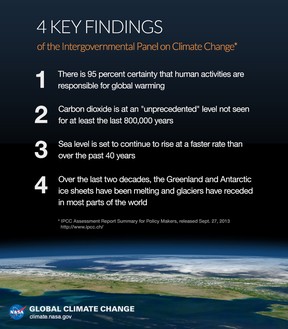
GUIDES AND LINKS
B.C. Flood: Read all our coverage on the Fraser Valley and beyond
Frequently asked questions about climate change: NASA
Climate change made B.C. heat wave 150 times more likely, study concludes
B.C.’s heat wave: Intense weather event is linked to climate crisis, say scientists
Expert: climate change expected to bring longer wildfire seasons and more area burned
Vancouver outlines its Climate Emergency Action Plan
COVID-19 may have halted massive protests, but youth are taking their fight for the future to the courts
Climate displacement a growing concern in B.C. as extreme weather forces residents out of their homes
Do you have a story idea about local efforts being made to address the climate and ecological emergencies? Please email tips to ticrawford@postmedia.com.
Support our journalism:Our in-depth journalism is possible thanks to the support of our subscribers. For just $3.50 per week, you can get unlimited, ad-lite access to The Vancouver Sun, The Province, National Post and 13 other Canadian news sites. Support us by subscribing today:The Vancouver Sun|The Province.


